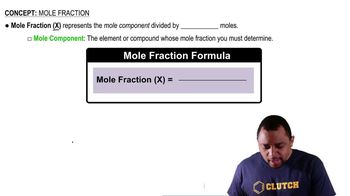You make a solution of a nonvolatile solute with a liquid solvent. Indicate if each of the following statements is true or false.
b. The freezing point of the solution is independent of the concentration of the solute.
 Verified step by step guidance
Verified step by step guidance


You make a solution of a nonvolatile solute with a liquid solvent. Indicate if each of the following statements is true or false.
b. The freezing point of the solution is independent of the concentration of the solute.
a. The vapor pressure of pure water at 60°C is 149 torr. What vapor pressure is predicted by Raoult’s law for a solution at 60°C that is 50 mol% water and 50 mol% ethylene glycol (a nonvolatile solute)?
At 63.5 °C, the vapor pressure of H2O is 175 torr, and that of ethanol (C2H5OH) is 400 torr. A solution is made by mixing equal masses of H2O and C2H5OH. (a) What is the mole fraction of ethanol in the solution?
At 63.5 °C, the vapor pressure of H2O is 175 torr, and that of ethanol (C2H5OH) is 400 torr. A solution is made by mixing equal masses of H2O and C2H5OH. (b) Assuming ideal solution behavior, what is the vapor pressure of the solution at 63.5 °C?